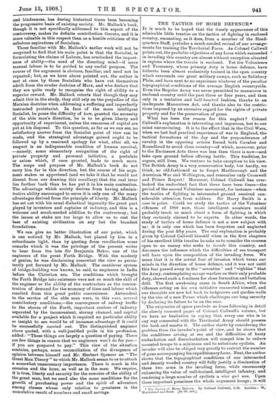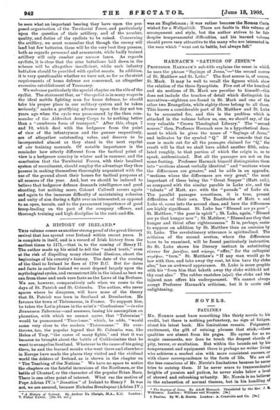THE TACTICS OF HOME DEFENCE.• IT is much to be
hoped that the timely appearanoe of this admirable little treatise on the tactics of fighting in enclosed country, emanating, as it does, from a member of the Head- quarters Staff, preludes a much-needed revisal of our arrange- ments for training the Territorial Force. As Colonel Callwell points out, the probable objectives of any force which succeeded in invading this country are almost without exception situated in regions where the terrain is enclosed. Yet the Volunteers and Yeomanry, whose primary duty is home defence, have hitherto been almost exclusively trained in the open country which surrounds our great military camps, such as Salisbury Plain, and have next to no experience whatever of the peculiar topographical conditions of the average English countryside. Even the Regular Army was never permitted to manoeuvre in enclosed country until the past three or four years, and then only in a tentative and half-hearted fashion, thanks to an inadequate Manoeuvres Act, and thanks also to the restric- tions imposed by an excessive regard for the rights of private property and for the preservation of game.
What has been the reason for this neglect ? Colonel Callwell's explanation is interesting and ingenious, but to our mind unconvincing. It is to the effect that in the Civil Wars, when we last had practical experience of war in England, the tactical formations of the day and the preponderance of cavalry in the opposing armies forced both Cavalier and Roundhead to avoid close country—of which, moreover, prior to the Enclosure Acts there was less than there is now—and take open ground before offering battle. This tradition, he argues, still lives. We venture to take exception to his view. The British Army is a very conservative body, but hardly, we think, so old-fashioned as to forget Marlborough and the American War and Wellington, and remember only Cromwell and Prince Rupert! Moreover, Colonel Callwell has over- looked the undoubted fact that there have been times—the period of the second Volunteer movement, for instance—when the tactics of fighting in intersected ground received con- siderable attention from soldiers. Sir• Harry Smith is a case in point. Could we study the tactics of the Volunteer riflemen of 1860 now, those intelligent amateurs would probably teach us much about a form of fighting in which they certainly claimed to be experts. In other words, the study of tactics of home defence is not a new subject with us : it is only one which has been forgotten and neglected during the past fifty years. The real explanation is probably given by Colonel Callwell himself when in the first chapters of his excellent little treatise he asks us to consider the courses open to an enemy who seeks to invade this country, and discusses the influence which the difficulties of sea transport will have upon the composition of the invading force. We mean that it is the actual fear of invasion which turns our minds in the direction of home defence, and it was not until this fear passed away in the " seventies " and " eighties " that the Army, contemplating savage warfare as their only probable duty, showed such a fondness for close formation and battalion drill. The first awakening came in South Africa, when the rifleman acting on his own initiative reasserted himself, and our thoughts are now led back to hedgerows and garden-walls by the rise of a new Power which challenges our long security by declaring its future to be on the seas. The exigencies of space preclude us from following in detail the closely reasoned pages of Colonel Callwell's volume, but we have no hesitation in saying that every one who is in any way connected with the Territorial Army should possess the book and master it. The author starts by considering the problem from the invader's point of view, and he shows that the conditions arising at sea and the difficulties of hasty embarkation and disembarkation will compel him to reduce mounted troops to a minimum and to substitute cyclists. An invader will also be obliged very greatly to restrict the number of guns accompanying his expeditionary force. Next, the author shows that the topographical conditions of our intersected and densely wooded country will fully justify a diminution of these two arms in the invading force, while enormously enhancing the value of well-trained, intelligent infantry. and rendering a large number of cyclists a sine qui non. Upon these important premisses the whole argument hangs ; it will
• The Tactics of How Defence. By Colonel Callwell, C.B. London: We Blackwood and Sous. Os. Gd. net.) be seen what an important bearing they have upon the pro- posed organisation of the Territorial Force, and particularly Upon the question of their artillery, and of the number, quality, and duties of the cyclists to be raised. Concerning the artillery, we must remember that though the enemy will land but few batteries, these will be the very best they possess, both as regards personnel and armaments, while badly trained artillery will only cumber our narrow lanes. As regards cyclists, it is clear that the nine battalions laid down in the gamine will be altogether insufficient, while each infantry battalion should be provided with cyclist scouts. In addition, it is very questionable whether we have not, so far as the strict requirements of home defence are concerned, an altogether excessive establishment of Yeomanry.
We welcome particularly the special chapter on the rile of the cyclist. The statement that, as " the cyclist is in many respects the ideal mobile fighting man for home defence, be should take his proper place in our military system and be taken Seribusly," marks a gratifying advance upon the day not ten years ago When the cycle was pronounced by the then com- mander of the Aldershot Army Corps to be nothing better than a " cuinbrous form of transport." After this, chaps. 7 and 10, which deal with the hedgerow from the point of view of the infantryman and the gunner respectively, are of altogether outstanding value, and deserve to be incorporated almost as they stand in the next reprint bf onr training manuals. Of notable importance is the retninder how utterly different from the tactical point of view is a hedgerow country in winter and in summer, and the conclusion that the Territorial Forces, with their localised system of recruitment, should employ the advantage they thus possess in making themselves thoroughly acquainted with the use of the ground about their homes for tactical purposes at fill seasons of the year. And, lest we should be induced to believe that hedgerow defence demands intelligence and good Shooting, but nothing more, Colonel Callwell recurs again and again to the immense difficulty of maintaining cohesion and unity of aim during a fight over an intersected, as opposed to an open, terrain, and to the paramount importance of good troop-leading on the part of the company officers, and thorough training and high discipline in the rank-and-file.







































 Previous page
Previous page